Published 29 AUG 2024
Oliver Bak
Ghost Driver, or The Crowned Anarchist
Opening – 13 SEP 2024, 6-10 pm
14 SEP till 2 NOV 2024
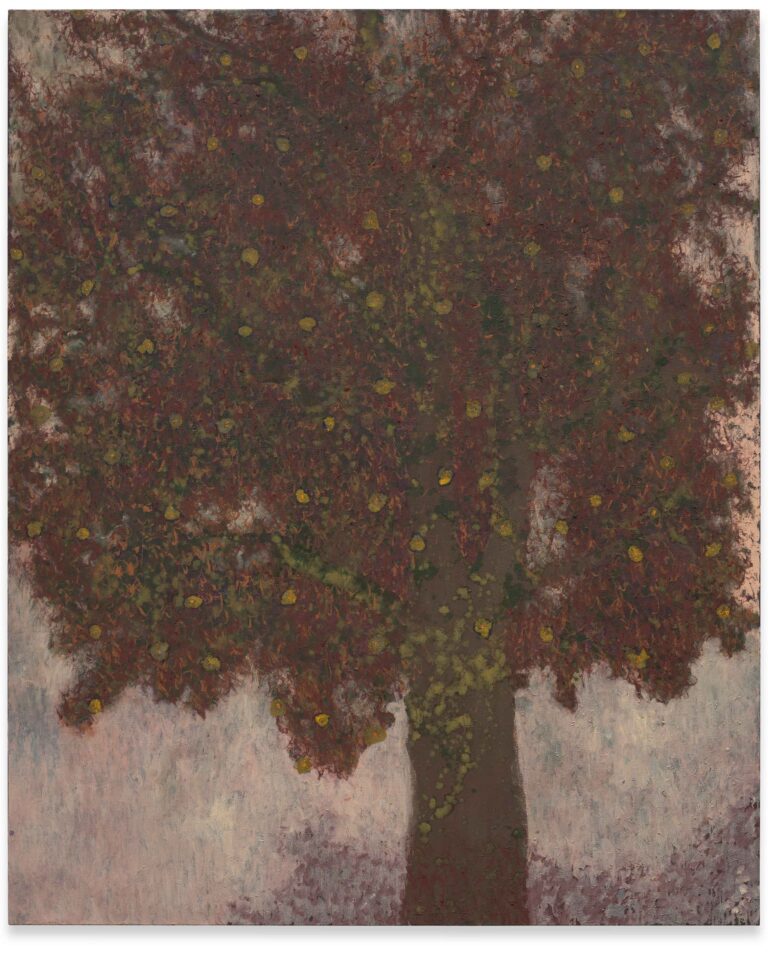
Oliver Bak
Autumn tree, 2024
Oil and wax on linen, 198 x 163 cm | 78 x 64 1/8 inches
© Oliver Bak
Courtesy the artist and Sprüth Magers
Photo: Timo Ohler
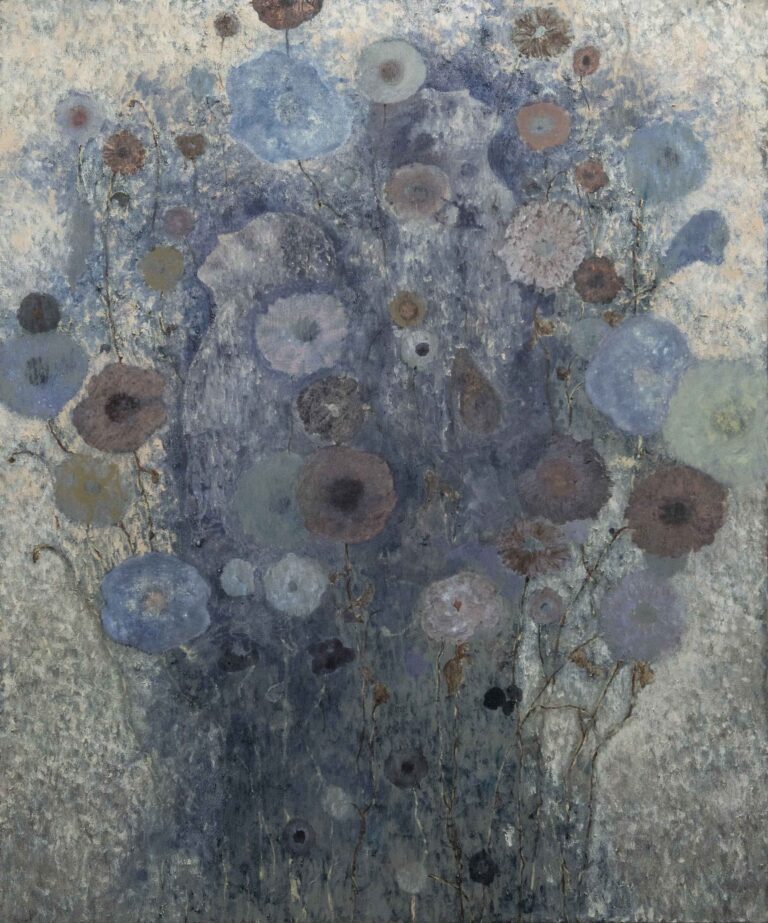
Oliver Bak
Bouquet, 2024
Oil and wax on linen, 137 x 114 cm | 54 x 44 7/8 inches
© Oliver Bak
Courtesy the artist and Sprüth Magers
Photo: Timo Ohler
The mystical scenes of painter Oliver Bak unite the spirits of the past and present. Drawing from fiction and the real, mythology and life, and the tangible and the subconscious, he constructs enigmatic narratives by conflating different fragments of reality. Bak’s pictorial worlds are propelled by constant synthesis and anchored in a deep understanding of the medium’s history. His mottled brushwork and magnetic use of colour evoke the dreamlike paintings of Symbolist, Surrealist and Nabi painters. Plants seem to sprout from the surface of his canvases and empyrean figures emerge from between leafy areas and flecks of light, breaking down spatial categories. Monika Sprüth and Philomene Magers are pleased to present Bak’s first exhibition at the Berlin gallery, marking the Danish artist’s debut show in Germany.
Bak’s new body of work surveys the intersections of beauty and horror, exploring how the inherent duality of Dionysus’ nature—the god of vegetation, fertility, and a symbol of death and resurrection—can be captured. Suitably, Bak looks to the myths surrounding the anarchist child emperor Heliogabalus for inspiration. Guided by an 1888 Victorian painting by Sir Lawrence Alma-Tadema that shows the ‘wicked’ Roman emperor smothering his guests to death in a shower of rose petals, as well as by the eccentric novelised biography of the third-century ruler written by French poet Antonin Artaud in 1933, Bak revives the romantic theme of beauty versus the inevitability of death and decay embedded in the natural world’s cycle of seasons. The tale—filtered through centuries of ideals and morals—of a short scandalous rule between riches, butchery, sexual excess, and decadence is translated into works exuding an equivocal and uncanny atmosphere.
In a lengthy process that takes months to years, he conjures ghostly fauna and figures that seem to haunt his works. The artist evolves his surfaces as highly textured topographies: thick layers of wax and impasto areas are reworked multiple times. Adding and subtracting paint, he sometimes upends his brush, forsaking its bristles for the wooden end. Slowly materialising with each mark and gesture, Bak gives life to characters from his imagination. Occasionally, he erases or destroys his creatures, capturing only their subliminal essence. For his supports, he often utilises vintage fabrics that amplify his moody colour palette. His faint drawings are preparatory sketches for the works in oil or, in some cases, stand-alone works developed independently from his painting practice. He deviates from his familiar process of subtraction and addition by using his fingers to smudge the graphite, creating depth in apparition-like, even eerie, images.
Bak’s paintings hide more than they show, their layers on layers of paint and references combining into deep repositories of emotions. At first glance, Bak’s images elicit unqualified pleasure in response to the beauty of the blossoms, delicate flora and foliage of the trees. But just as the pink petals in Alma-Tadema’s The Roses of Heliogabalus conceal its violent subject matter, underneath Bak’s vegetation loom disturbing shadows full of ambiguity—injecting each work with a foreboding quality.
Resisting the idea of the past, present and future as a linear progression of events, Bak’s re-imagining of myths let time collapse. The works’ many layers provide a space for contemplation and hint at an undefinable interiority that is absolutely and resolutely human, ultimately enabling the viewer to perceive the invisible.
Born in 1992 in Denmark, Oliver Bak lives and works in Copenhagen. Recent Solo Exhibitions include Caves in the Sky, Cassius & Co, London (2023) and Sick with Bloom, ADZ, Lisbon (2022).
John Baldessari
Ahmedabad 1992
Opening – 13 SEP 2024, 6-10 pm
14 SEP till 2 NOV 2024
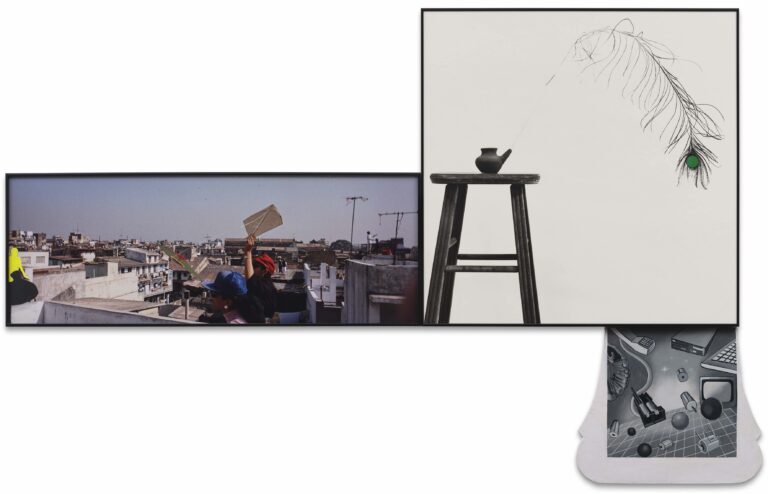
John Baldessari
Person with Kite (With Yellow and Black Intrusions) /Feather (Flawed), 1992
One black-and-white photograph with acrylic paint and paper adhesive; one color photograph with acrylic paint; oil enamel paint on rubber
130.2 x 205.7 cm (overall) | 51 1/4 x 81 inches (overall) (framed)
© John Baldessari 1992
Courtesy Estate of John Baldessari; John Baldessari
Family Foundation; Sprüth Magers
Photo: Ben Westoby
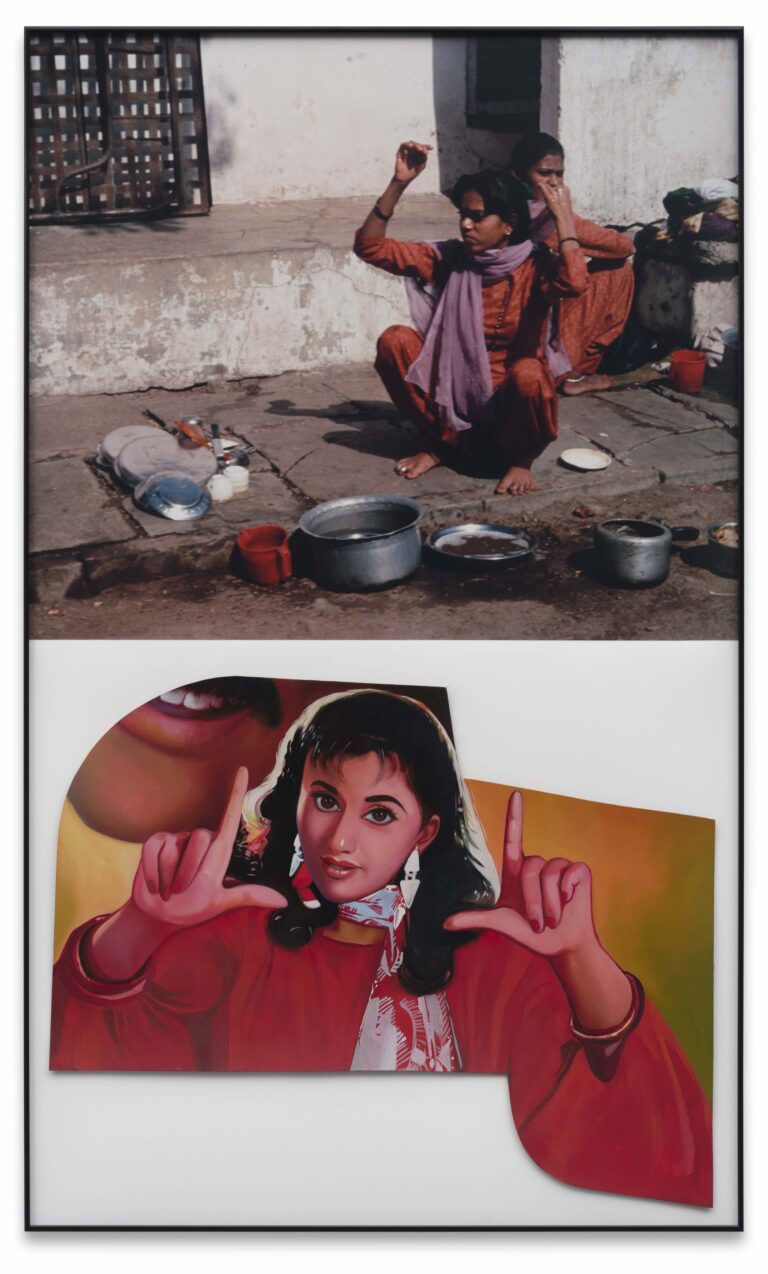
John Baldessari
Two Gestures (Female), 1992
One color photograph; oil enamel paint on Masonite (mounted on Formica)
144.8 x 86.7 cm | 57 x 34 1/8 inches (framed)
© John Baldessari 1992
Courtesy Estate of John Baldessari; John Baldessari
Family Foundation; Sprüth Magers
Photo: Ben Westoby
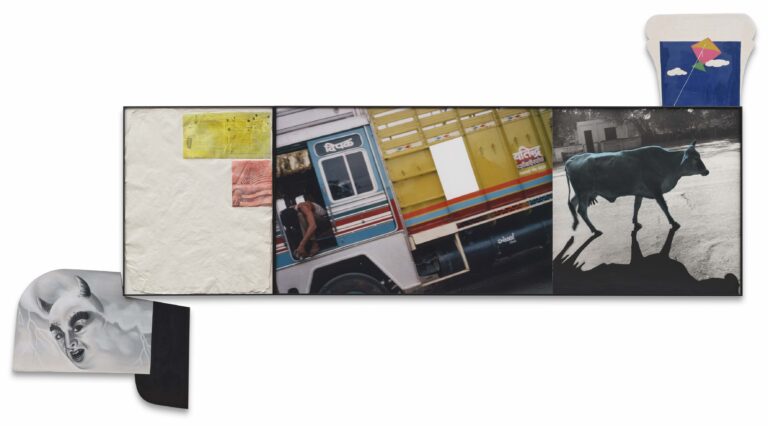
John Baldessari
Truck (with White Intrusion)/Cow (Blue), 1992
One black-and-white photograph with oil tint; one color photograph with acrylic paint; photocopy transfer on handmade paper with acrylic wash; oil enamel paint on rubber; oil enamel paint on Masonite (mounted on Formica)
181.6 x 340.4 cm (overall) | 71 1/2 x 134 inches (overall) (framed)
© John Baldessari 1992
Courtesy Estate of John Baldessari; John Baldessari
Family Foundation; Sprüth Magers
Photo: Ben Westoby
Throughout John Baldessari’s prolific and impactful career, he consistently examined and defied the expectations that influence our perception of art. His unique methodology in the realms of painting, photography, source materials, and text redefined and challenged conventional art historical limitations, making him a pioneer of American Conceptualism. Drawing from a wide range of sources—advertising, film culture, Marcel Duchamp, and Ludwig Wittgenstein—he created absurdist, complex yet accessible juxtapositions. Monika Sprüth and Philomene Magers are pleased to present the second iteration of Ahmedabad 1992, a solo exhibition of an alluring series of mixed media assemblages Baldessari produced during his residency in India. For the first time in decades, a selection from this unique period in the artist’s oeuvre was initially shown during summer 2024 at the London gallery. Introducing the body of work to Berlin viewers, Ahmedabad 1992 will travel to the gallery’s German space for Berlin Art Week. An accompanying catalogue with contributions by Shanay Jhaveri and Mario d’Souza will be published to mark the occasion.
In the early weeks of 1992, Baldessari was invited to live and work in the expansive compound of the Sarabhai family, Indian industrialists and patrons of the arts, in the Shahibaug district of Ahmedabad. Members of the prominent family formally set up the residency in the 1970s, but the Sarabhais were interacting with artists, designers and architects long beforehand. Like many patrons and cultural protagonists of post-independence India, they actively engaged with foreign artists and established international networks, hoping to restrain revivalist currents and promote a new vision for the country. Following several other established artists, among them his close friend Lynda Benglis, Baldessari resided in the Villa Sarabhai, a red brick and concrete open-plan house designed by Le Corbusier in the 1950s.
The rarely seen multi-panelled works that stem from Baldessari’s stay are a direct response to his new surroundings, which were inspiring and overwhelming in equal measure and had a lasting impact on the artist’s oeuvre. The collages are composed of his own photographs, some enhanced by paint; an eclectic mix of found imagery; rubber mudflaps painted by local sign painters; Formica pieces modelled after parts of local motorised rickshaws; and printed handmade paper collected from the Gandhi ashram in Ahmedabad. Immersing himself in Indian culture, the Californian photographed the bustling city at a time when India was subject to radical changes due to the emergence of new technologies, globalisation processes, and an influx of Westerners.
The cleverly devised arrangements of Ahmedabad 1992 document this shift. Here, floating electronics in a futuristic cyberspace point towards the burgeoning technological revolution of the ’90s. There, a sense of motion and transition is reflected in the dominant motifs, including modes of transportation (motorbikes, bicycles, trucks), animals in movement (a cow trotting along the roadside or a bird in flight), and cricket being played or kites being flown. Also at constant play in the series is the alternating and interlacing of looking and being looked at, with several images either observing the action of street scenes or featuring a subject’s direct gaze, and sometimes both.
Cornerstone aspects of Baldessari’s practice, like the mining of pre-existing imagery, fell on fertile ground in a place as visually spectacular as India. Images from magazines and the everyday are deconstructed and reassembled to stress their original ambiguity or curiousness. Figures are painted over, withdrawing the underlying information and complicating the reading of the image. Expanding on this sort of erasure, Baldessari produced the Removal Series (1995) shortly thereafter. Also employed in the present works is the use of dots to cover faces, a predominant feature of the artist’s work from the mid-1980s onward, which simultaneously draws the eye to the point of obfuscation and redirects the viewer towards other parts of the image. The resulting works, which Baldessari produced after his return to Santa Monica, expand beyond the sum of their parts and evoke the atmosphere and complexity of Indian scenery through associative juxtaposition.
The artist’s signature wry humour gives way to a surprisingly raw view of everyday settings. Entered into new contexts, they are recoded and refuse immediate answers, allowing viewers to generate their own responses. The residency provided him with a unique opportunity to not only observe a new environment, which in many ways contrasted his Los Angeles milieu, but also permitted him to turn a critical lens inward for a period of self-reflection. It is the works’ contingent quality—with each element modifying the next—Baldessari’s vibrant use of colour, and the keen eye of an outsider that render the Ahmedabad series an intimate commentary on what it means to look during a moment of reinvention.
John Baldessari (1931–2020) lived and worked in Venice, California. Selected solo exhibitions include Fundación Malba–Museo de Arte Latinoamericano de Buenos Aires (2024), Moderna Museet, Stockholm (2020), Laguna Art Museum, Laguna Beach (2019), Museo Jumex, Mexico City (2017), Städel Museum, Frankfurt (2015), Garage Center for Contemporary Culture, Moscow (2013), Fondazione Prada, Milan (2010), Stedelijk Museum, Amsterdam (2011) and Tate Modern, London (2009), which traveled to Museum of Contemporary Art, Barcelona (2010), Los Angeles County Museum of Art (2010), and Metropolitan Museum of Art, New York (2010–2011). Selected group exhibitions include the 53rd Venice Biennale (2009) at which he was honored with the Golden Lion for Lifetime Achievement, Whitney Biennial (2009, 1983), Documenta VII (1982), Documenta V (1972) and the Carnegie International (1985–86).
